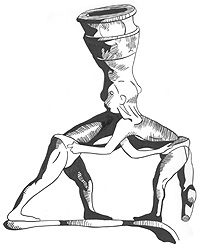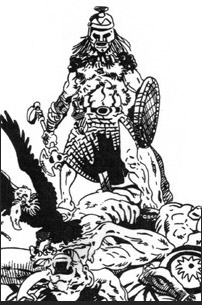I’m an aspiring horror writer, and have been reading your stuff—read Ann’s Graphomaniac article. I just finished Virtius Maniples. It jumps around a bit—I realize this is due to your subtle exposition. It is the most masculine horror I have ever read and, significantly, it remains horror while being masculine. You really have that down. I’m working on a story in which I want to express my masculine anger at the way the world is, and was wondering if you have any tips.
Don’t feel bad. I’ve got a thing for Ann too. I wish we could clone her!
Thanks! Melvin
Thanks for the props Melvin. I am not a horror writer and have hardly read or viewed anything in the genre. I’m writing horrific sci-fi, and that is why Winter jumped around for you. If I’m going to realistically explore the subject of racial memory and genetic vengeance I can’t very well have the characters know what’s up. Purist science fiction, where exposition is limited to hints, is too much of a lineal puzzle for most readers. For instance, sci-fi written for women and manginas [most of it] is really soap-operatic fantasy. The female and feminized reader desires to know more than the character and wants to know everything the narrator [writer] knows.
Writing sci-fi like this ruins it for the dedicated sci-fi reader, which is who I write for. So you have to be careful about being too oblique and vague with your exposition or you will end up being a slow seller like me.
A good example is Hallowed my early story about a pumpkin, from the pumpkin’s point of view. Non sci-fi readers never got that Ethan was a pumpkin and thought this was a weird sci-fi story about an alien invasion. Most of the sci-fi readers got it right away and just read along to see how closely I tread the exposition line, essentially using me as a work study. Only one reader said, “Ha, I thought Ethan was a religious alien on a garden planet, until the end when I finally realized he was a pumpkin getting carved up for Halloween!”
That’s called a miss!
For your anger-against-the world story, which I imagine will have an apocalyptic element, the obvious route is to pitch your story from the perspective of an angry character critical of the world. I would avoid that, as then the reader begins focusing on the character, seeing the author’s hand clearly.
You want to obscure your hand—don’t want to be Michael Angelo signing the ceiling of the Sistine Chapel in large block letters—but rather wanting the viewer to think the art was made by God through some mortal’s hand.
If you do, let’s say, a story from the perspective of a teacher, who believes in this corrupt world, and is dealing with a reclusive student—that student could be your muted voice of protest.
Let’s say you write a story about mandatory cross-dressing in public school, which I believe will be a educational policy along the lines of African History Month within 30 years—write it from the perspective of the teacher enforcing the cross-dressing school policy, and explaining to the poor misguided student why his hairy lumberjack father has led him down a hateful path, and why he needs to get in touch with his feminine side and explore gender options. Make the teacher a caring compassionate soul, and the student an asshole.
Try that Melvin, and good luck.











